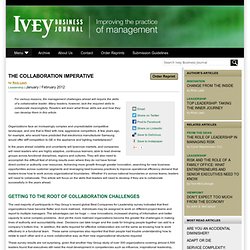

Introduction to Collective Intelligence. How to Cultivate Collective Intelligence. The first time I heard the word "swarming" in a business context, it made me chuckle. I had an instant visual of bees dressed in suits and carrying briefcases, furiously buzzing over, under, and around a conference table. They weren’t accomplishing anything—just making a lot of noise and looking for something to sting. Then it occurred to me that all worker bees are female. Each bee in my mental image was now wearing a suit with a skirt, and red high heels on all six feet. By this point I was ready to give up on the idea of swarming in business altogether.
However, I am a huge believer in collective intelligence, whether at work or in the wild. Similarly, the human brain is naturally wired for empathy, connectivity, and collaboration. An important issue may develop in another time zone across the world, or an immediate deadline may be set. Progress will depend on your ability to bring together highly functioning groups of diverse people.
Collective Intelligence. Collective Intelligence As we explore ways to generate more effective groups, organizations, institutions, and other human systems, it may help to begin by taking a closer look at collective intelligence.

When I investigate the problems that we face in the world today, I seldom find that individual evil is a central cause. More often I find basically good, intelligent people collectively generating discord and disaster -- in families, groups, organizations, nations and the world. Meanwhile, in their own lives, from their own perspective (and usually that of their loved ones), most of them are doing perfectly good, decent things. How can this be? Clearly individual intelligence is not enough. There are many different kinds of collective intelligence, including To date, much has been learned about how to develop collective intelligence within organizations-usually to help corporations become more competitive in the global market.
Collaborative Leadership. What is collaborative leadership?

Why practice collaborative leadership? When is collaborative leadership appropriate? Who are real and potential collaborative leaders? How do you practice collaborative leadership? Consider two communities' efforts to address teen pregnancy. In Putnam, the mayor decides that teen pregnancy is a problem, and that it makes the town look bad. The aide summons the members of the coalition to a meeting, explains what the mayor wants, and quickly gets it, over objections from one of the agency directors that the problem is complex and needs more exploration. Down the road in George City, a group of teen parents and parents of teens have also been meeting to talk about the teen pregnancy issue. The group is facilitated by the head of a youth leadership agency, a woman respected by both teens and the community. Would it surprise you to learn that, after two years, there had been no reduction - a slight increase, in fact - in the Putnam teen pregnancy rate?
Buy-in. The ABC’s of Collaboration. (Editor’s Note: scroll down for graphical versions) In my book, Flat Army: Creating a Connected and Engaged Organization (Wiley) I define collaboration as follows: The unfettered allowance and encouragement of employees to both contribute and consume knowledge, insight or ideas with any direct relationship via professional or personal networks to achieve an outcome.

If we were to elaborate on the definition, we might suggest there are ‘The ABC’s of Collaboration’: Accessible – Be approachable & available to your team & those who expect your insight & opinions.Benevolent – To be disposed and to want to do good is a key part of being collaborative with others.Challenge – Groupthink does not equal collaboration.
To challenge is to professionally debate by collaborating.Deliver – Be free from restraint while getting things done. There are two infographic versions of “The ABC’s of Collaboration” found below. I’m taking a writing break for the summer. Do you dare to share? The Collaboration Imperative. For various reasons, the management challenges ahead will require the skills of a collaborative leader.

Many leaders, however, lack the required skills to collaborate meaningfully. Readers will learn what those skills are and how they can develop them in this article. Organizations face an increasingly complex and unpredictable competitive landscape, and one that is filled with new, aggressive competitors. A few years ago, for example, who would have predicted that electronics manufacturer Samsung would offer stiff competition to GE in the appliance and lighting marketplaces? In the years ahead volatility and uncertainty will tyrannize markets, and companies will need leaders who are highly adaptive, continuous learners, able to lead diverse groups across functional disciplines, regions and cultures. Getting to the root of collaboration challenges Why has the development of collaborative leadership skills lagged the evolution of organizational structures? Collaborating in the matrix 1. The 12 Habits Of Highly Collaborative Organizations.